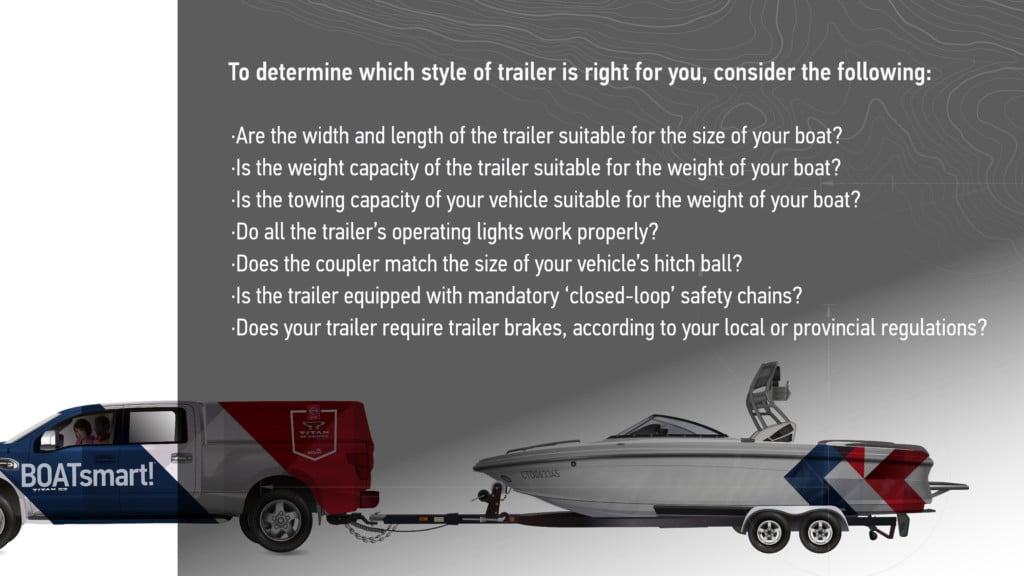Boat Trailering: Transporting your Boat Safely
Transporting your boat safely isn’t difficult. Boat trailering is a matter of choosing the right towing equipment, using common sense when loading and unloading your boat, and being confident with the techniques for driving safely with a trailer.
How to choose the right boat trailer
To determine which style of trailer is right for you, consider the following:
- Are the width and length of the trailer suitable for the size of your boat?
- Is the weight capacity of the trailer suitable for the weight of your boat?
- Is the towing capacity of your vehicle suitable for the weight of your boat?
- Do all the trailer’s operating lights work properly?
- Does the coupler match the size of your vehicle’s hitch ball?
- Is the trailer equipped with mandatory ‘closed-loop’ safety chains?
- Does your trailer require trailer brakes, according to your local or provincial regulations?
Towing your Boat
When driving, remember that your vehicle is longer and heavier than it was before the trailer was attached.
To drive safely with a boat trailer in tow, you should:
- Increase your speed slowly and drive at a slower speed than normal
- Make wider turns to allow for the trailer
- Allow for greater braking distance
- Use extra caution when driving in windy, rainy, foggy or icy conditions
Remember that you must follow provincial and local laws for trailer licensing, registration and operating lights. Always practice towing, driving, and backing up with your trailer in a controlled environment before heading out on the road.
How to attach the trailer to your vehicle:
- STEP 1: Ensure that the trailer is properly balanced and level.
- STEP 2: Position the trailer so that the hitch ball is directly below the trailer’s coupler.
- STEP 3: Lower the trailer’s coupler on to the hitch ball so that it is securely fastened, lock the trailer latch and secure it using a cotter pin or lock.
- STEP 4: Using tie down straps, securely fasten the boat to the trailer.
- STEP 5: Attach the winch cable and/ or winch safety chain to the bow eye of the boat.
- STEP 6: Insure that the trailers safety chains are securely fastened to the hitch. Chains should be long enough to accommodate tight turns, but short enough so that the tongue of the trailer cannot touch the road if it becomes dislodged from the hitch.
- STEP 7: Fasten the trailer light hook-ups to your vehicle and check that all lights are working properly.
Launching and Loading your Boat
Launch Ramp Courtesy:
When launching or loading your boat at a public boat launch, always remember to be courteous to other boaters. Never hog the ramp, and always be prepared to launch and load your boat efficiently.
Here are a few basic launch ramp courtesy tips:
- When you arrive at the boat launch area, always park away from ramp, never block the ramp with your vehicle.
- If you need to inspect the launch area, walk over to check it out – don’t park in front of the ramp.
- Load any gear and equipment, and remove any tie-down straps away from the launch area.
- Wait until the launch area is clear, before backing your boat into the water.
- Once your boat has been launched, move both your boat, and towing vehicle away from the launch area as efficiently as possible, to make room for other boaters.
How to Launch your Boat
- Step 1: Check the launch area for any obstructions, and ensure that the launch ramp area is deep enough for your boat.
- Step 2: Remove all tie-down straps from the boat and trailer and unplug the trailer lights from your vehicle.
- Step 3: Ensure that the bilge drain plug is in place.
- Step 4: Load all gear and safety equipment on board the boat.
- Step 5: Ensure the winch is connected to the bow of the boat and that you’ve attached the boat’s bow and stern lines
- Step 6: Slowly back the trailer up on the launch ramp until the motor is under water.
- Step 7: Start the boat’s motor and allow it to warm up.
- Step 8: Shut down the motor, and continue backing the trailer into the water until the boat begins to float
- Step 9: Use the boat’s bow and stern lines to guide the boat off the trailer and then remove the vehicle from the ramp.
How to load your boat on to the trailer:
- Step 1: Secure the boat at the dock.
- Step 2: Back the trailer into the water until it is two-thirds submerged.
- Step 3: Turn off your vehicle and engage the emergency brake.
- Step 4: Position the boat on the trailer using the bow and stern lines–do not drive your boat onto the trailer.
- Step 5: Attach the winch line to the bow-eye of your boat and pull the boat up onto the trailer using the winch.
- Step 6: Ensure the boat is properly seated and balanced on the “bunks” or rollers
- Step 7: Once the boat is in position, lock the winch and attach the winch safety chain (if so equipped).
- Step 8: Remove your trailer and vehicle from the ramp.
- Step 9: Once parked, attached the trailer lights, and ensure that they are working properly
- Step 10: Remove the boats bilge drain plug.
- Step 11: Secure the boat using tie-down straps secured to the transom, before departing.



To the boatsmartexam.com webmaster, Your posts are always well-received and appreciated.